
|
|
March 20-27, 2002
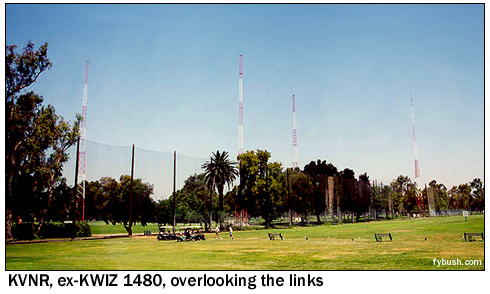 "We Love L.A.,"
Part Two
"We Love L.A.,"
Part Two
When we left you last time, we were heading south towards San Diego, for what proved to be a fun-filled weekend visiting that city's unusual assortment of towers (including one of the few drive-through directional arrays) and slipping across the border for a quick look at some of Tijuana's broadcast highlights. (There was also the family wedding that was the ostensible purpose of the trip, but I digress...)
We'll return to those Southland sites another time - but for now, we pick up our trip in Orange County, where we spent a chunk of the day engaged in non-radio activities (a fascinating visit to the Richard Nixon presidential museum), interspersed with a few sites of note.
There's not much radio in Orange County, at least compared with the population explosion there in recent decades, but a few sites stand out. Next to a busy golf course in Santa Ana, we found the station formerly known as KWIZ, with its four towers on 1480. It's now KVNR, programming in Korean, but the KWIZ calls live on: not only do they adorn the studio/transmitter building, they're also still on 1480's former FM sister, now programming in Spanish on 96.7.
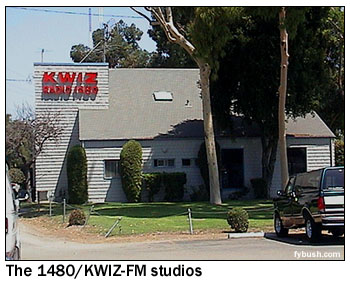
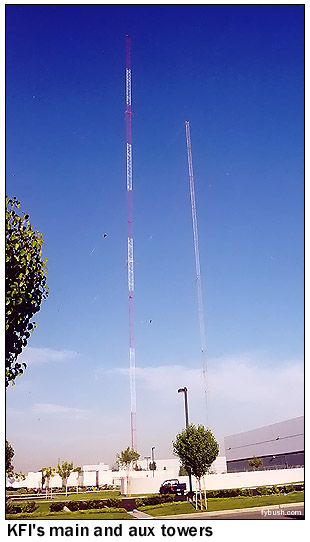 A
more recent addition to the Orange County dial is KPLS (830),
doing conservative talk, but we didn't make it to those towers,
or to the nearby site of the Anaheim-licensed 1190, whatever
its calls might be this week (it'll always be KEZY to us, anyway.)
A
more recent addition to the Orange County dial is KPLS (830),
doing conservative talk, but we didn't make it to those towers,
or to the nearby site of the Anaheim-licensed 1190, whatever
its calls might be this week (it'll always be KEZY to us, anyway.)
Where Orange County, Los Angeles County and I-5 intersect near Buena Park, though, we found another highlight of the trip: the historic transmitter site of KFI, the lone I-A clear channel in Southern California. This must once have been a remote, rural area - but that was a long time ago!
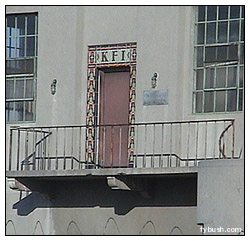 Today,
KFI sits within sight of one of the nation's busiest highways,
in an area long since overrun with industrial development. The
land is valuable enough that KFI long since sold off most of
its property, leaving the half-wave main tower and the shorter
aux enclosed within circular brick walls in the midst of a group
of warehouses!
Today,
KFI sits within sight of one of the nation's busiest highways,
in an area long since overrun with industrial development. The
land is valuable enough that KFI long since sold off most of
its property, leaving the half-wave main tower and the shorter
aux enclosed within circular brick walls in the midst of a group
of warehouses!
The KFI transmitter building is an Art Deco gem: 1930s-vintage concrete, with a spiral staircase behind a curving wall providing what appears to be the only access to the front door on the second floor! (And look at the tile work around the door - they don't build them like this anymore...)
While it's certainly unusual to see a station this powerful surrounded by development this close, KFI isn't quite unique -- in a future Site of the Week, we'll show you WSB in Atlanta, whose tower now sits as the centerpiece of a shopping center!
In fact, KFI isn't even quite unique in Southern California where warehouses and tower sites are concerned.
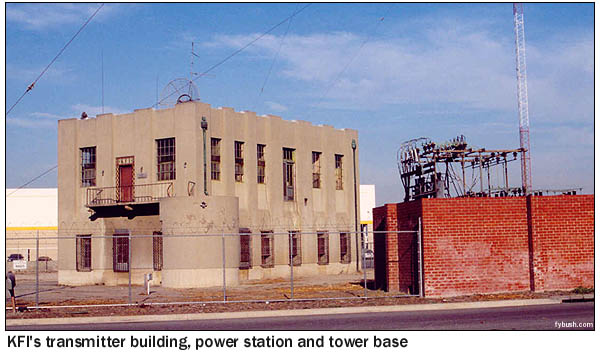 Branch off I-5 to
I-605 (the locals would call it "the 605," of course)
a few miles north of the KFI site and keep going, and before
long you'll find yourself in El Monte, deep in the San Gabriel
valley east of Los Angeles.
Branch off I-5 to
I-605 (the locals would call it "the 605," of course)
a few miles north of the KFI site and keep going, and before
long you'll find yourself in El Monte, deep in the San Gabriel
valley east of Los Angeles.
It's a short detour off the highway to our next stop, which was built to house just one L.A. station, the 50,000-watter on 1020 once known as KFVD and KGBS.
Since the seventies, 1020 has been known as KTNQ, which once stood for the top-40 "Ten-Q" format but has spent much longer as a Spanish-language outlet.
At the moment, it's simulcasting the "Recuerdos" format from several of Hispanic Broadcasting's L.A. FM outlets for most of the day, with Spanish sports talk at night -- but it's no longer the only occupant of this five-tower array on the roof of a huge warehouse building.
For the last few years, L.A.'s 1150 outlet has been diplexing from this site, aiming its own 50,000 watt signal east towards the city as KXTA with Fox Sports. (We'll learn much more about this frequency's colorful history in next week's installment...)
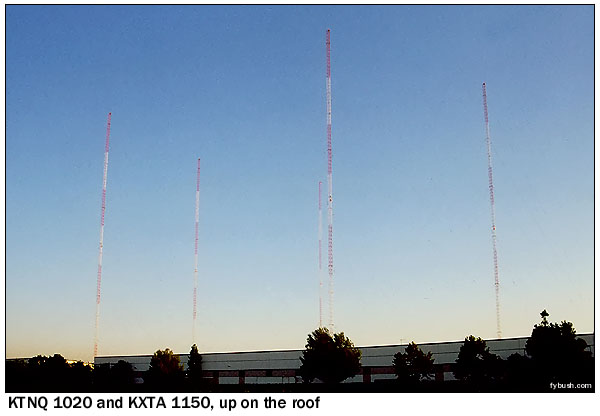 It's
just a few miles more on the 605 to the Baldwin Park-Irwindale
area, where we find our next L.A. signal.
It's
just a few miles more on the 605 to the Baldwin Park-Irwindale
area, where we find our next L.A. signal.
Actually, the station on 1110 isn't, technically, a Los Angeles station.
As KXLA, then as KRLA, this frequency pounded the hits into the L.A. basin for decades while licensed to suburban Pasadena.
It's still a Pasadena license, but there are no hits coming from these five towers these days; after a stint under Infinity ownership as a talker, 1110 was sold to Disney a few years ago to keep Infinity under the ownership cap, turning KRLA into KSPN, "ESPN Radio 1110" for the Southland.
Listen carefully amidst the programming from Bristol, Connecticut and you'll hear a local afternoon show, but little else to give away 1110's long history as a major Los Angeles radio voice.
(The KRLA call letters live on, down the dial at the Glendale-licensed 870 facility that was known for decades at KIEV, where they're being used with a diet of syndicated and local talk. We never did make it to the 870 site in the Eagle Rock area north of downtown L.A., but it's on the list whenever we have a chance to return to Southern California...)
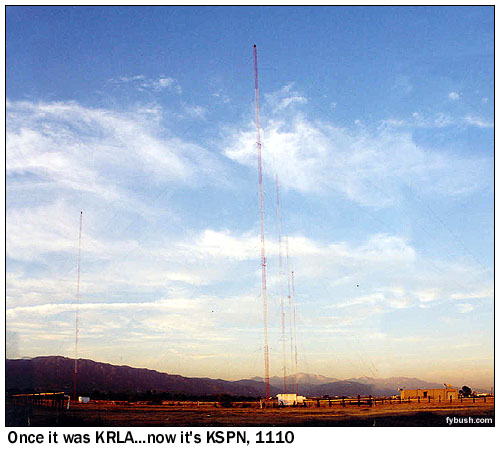 We had hoped to
make the next stop up in the hills northeast of L.A., at the
Mount Wilson TV-FM antenna farm that provides nearly all the
big signals to Southern California, but time was not in our favor.
(If any L.A. engineers are reading this, we'd love a tour of
Wilson on a future Southland visit...)
We had hoped to
make the next stop up in the hills northeast of L.A., at the
Mount Wilson TV-FM antenna farm that provides nearly all the
big signals to Southern California, but time was not in our favor.
(If any L.A. engineers are reading this, we'd love a tour of
Wilson on a future Southland visit...)
With sunset approaching, we headed instead to downtown Pasadena and another brush with radio's distant past.
In the dawn of radio (think 1924, here), it was not at all unusual for several stations in a big city to share a frequency - and not uncommon at all for one or two of those stations to belong to churches.
The Pasadena Presbyterian Church joined the trend that very year when it put KPPC on the air, running a mighty 100 watts and operating Sundays and one evening a week.
Most of those church stations either disappeared or were sold, but KPPC lived on - and on and on. As the AM dial took its present form in the L.A. basin, KPPC ended up on 1240 kHz, still operating only on Sundays and (I believe) Wednesday nights, still with 100 watts from a wire strung from the roof of one of the church's buildings to a taller building across the parking lot. When KPPC was on the air, KGFJ in Los Angeles on adjacent 1230 had to power down to 100 watts, long after it had increased to 250 and then 1000 watts. So did the station on 1240 in San Bernardino, an hour to the east.
In the meantime, the church went out and obtained an FM license when nobody wanted one - and KPPC-FM went on to make some radio history of its own when the church leased it out to freeform FM pioneers Tom and Rachael Donohue.
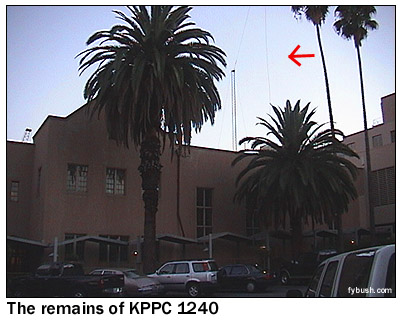 For a few years,
the basement of the church was home to one of the nation's first
and foremost underground FM rock stations! KPPC-FM on 106.7 was
eventually sold (to a predecessor of today's Infinity Broadcasting),
becoming today's modern rock KROQ.
For a few years,
the basement of the church was home to one of the nation's first
and foremost underground FM rock stations! KPPC-FM on 106.7 was
eventually sold (to a predecessor of today's Infinity Broadcasting),
becoming today's modern rock KROQ.
But back to that AM frequency: all the while, KPPC continued to sign on with its 100 watts twice a week, while KGFJ and the San Bernardino station powered down. Amazingly, the situation persisted that way well into the nineties, when the church finally sold AM 1240.
The station ended up in the hands of Douglas Broadcasting, which had also purchased KGFJ, soon renamed KYPA. KPPC also got new "Personal Achievement Radio" calls (KXPA, if memory serves; Douglas also ended up with the 1220 out in Pomona, which was renamed KWPA for a time), but its on-air career was finally at an end, with the license eventually returned to the FCC to give 1230 a full-time kilowatt of power.
That's the history; the legacy can still be seen in the church parking lot, where that wire antenna still stretches overhead as a quiet reminder of a long-gone day in Southern California broadcasting. Now you're in on the secret, too. (And just wait until you see the 1230 antenna, in the next installment of Site of the Week...)
KPPC isn't the only interesting bit of wire in the L.A. skies: the next day found us trekking up the 405 into the San Fernando Valley to see another unusual site.
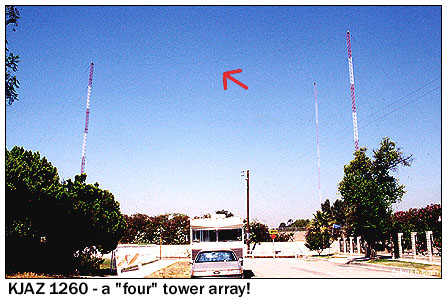 Look carefully to
the left of the arrow in the slightly enhanced photo at the right:
that's a vertical wire hanging from a horizontal wire strung
between two of the three "real" towers at the valley's
AM 1260.
Look carefully to
the left of the arrow in the slightly enhanced photo at the right:
that's a vertical wire hanging from a horizontal wire strung
between two of the three "real" towers at the valley's
AM 1260.
Long known as KGIL, this station has been a little bit of everything in recent years, changing city of license from San Fernando to Beverly Hills and changing calls on what's seemed like an annual basis. When we pulled up at the site, near Van Nuys Boulevard and Nordhoff Street, it was KJAZ, simulcasting a jazz format with co-owned XEJAZZ on 540 down in Tijuana.
(Owner Saul Levine also owned the 540 facility that was once licensed to Costa Mesa, aiming its power across the desert from some 80 miles away at a transmitter site south of San Bernardino in Moreno Valley. That station has since gone silent. Levine also owned the 1650 expanded-band sister to the 540 signal, which did everything from all-traffic to all-Beatles to a simulcast with 1260 before going Korean as KFOX. And he's best known for his Los Angeles FM at 105.1, long known as KKGO and doing jazz, now all-classical as KMZT.)
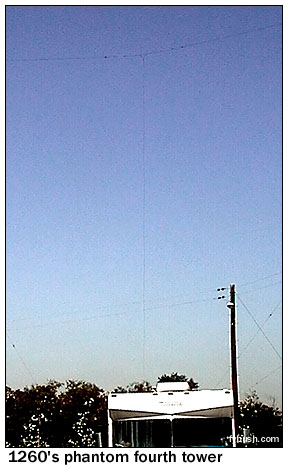 As we
go to the Net with this installment, 1260 is changing to adult
standards, again, as KSUR...
As we
go to the Net with this installment, 1260 is changing to adult
standards, again, as KSUR...
The technical facilities haven't changed, though: it's still a "phantom" four-tower array, using that long wire as the fourth tower.
While up that way, we had a chance to hear some of the Valley's other offerings, most notably the public radio from California State University-Northridge, KCSN 88.5, and the all-Iranian programming from KIRN (670) over in Simi Valley.
After another non-radio excursion, to the Getty Museum that crowns the ridge that separates the Valley from L.A.'s Westside, we made one more radio-history excursion for the day: a stop along Mulholland Drive, the mansion-encrusted scenic drive that winds along the top of the ridge.
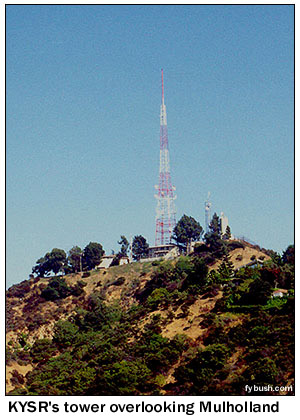 From there, you
can see a tower that just about everyone has seen at one time
or another, without ever realizing it.
From there, you
can see a tower that just about everyone has seen at one time
or another, without ever realizing it.
The site is known as "Mount Lee," and it was here that TV and FM in Los Angeles were born, thanks to Don Lee, the entrepreneur (and Cadillac dealer) responsible for the early days of KHJ.
Lee put L.A.'s first FM station - in fact, the first in the West - on the air here in 1941, under the calls K45LA at 45.5 MHz. A year earlier, he moved his pioneering TV station, W6XAO, up here from down in the city.
K45LA would become KHJ-FM at 101.1, the ancestor of today's KRTH; W6XAO would become KTSL on channel 2. In the early fifties, KTSL was sold to CBS (when Lee's family purchased KFI-TV 9, which then became KHJ-TV), moving to Mount Wilson and becoming KNXT and later KCBS-TV.
There hasn't been TV or FM up here for years, but the tower on Mount Lee remains a familiar icon. Where have you seen it? In just about any aerial shot that also shows the south-facing slope beneath the tower - for it's there that the world-famous "HOLLYWOOD" sign is perched! How's that for a high-visibility location?
Postscript: I thought I had taken a picture of Mount Lee, and posted it here as such - only to receive e-mail from engineer David Greene telling me that the picture seen at right above is in fact a different nearby site, that of KYSR 98.7. Not to worry, though; there's plenty of history here as well. The station signed on from here in 1948 as KMGM-FM, owned by the movie studio of the same name, and lasted just a couple of years before going silent. Reborn a few years later as KCBH ("Crawford's of Beverly Hills," named after the new owner), the station operated from the ultra-modern home seen at the base of the tower. The station later went through several more incarnations, including KJOI, before ending up as modern AC "Star" with a grandfathered superpower signal from this prime site. (Thanks, David!)
In our third, and final, L.A. installment next week, we'll check out some of the AM sites east of downtown and take a drive around the Hollywood studios...don't miss it!
- Previous Site of the Week: We Love L.A., part I
- Next Week: We Love L.A., part III
- How can you help support Site of the Week? Click here!
- Submit your suggestions for a future Site of the Week!
